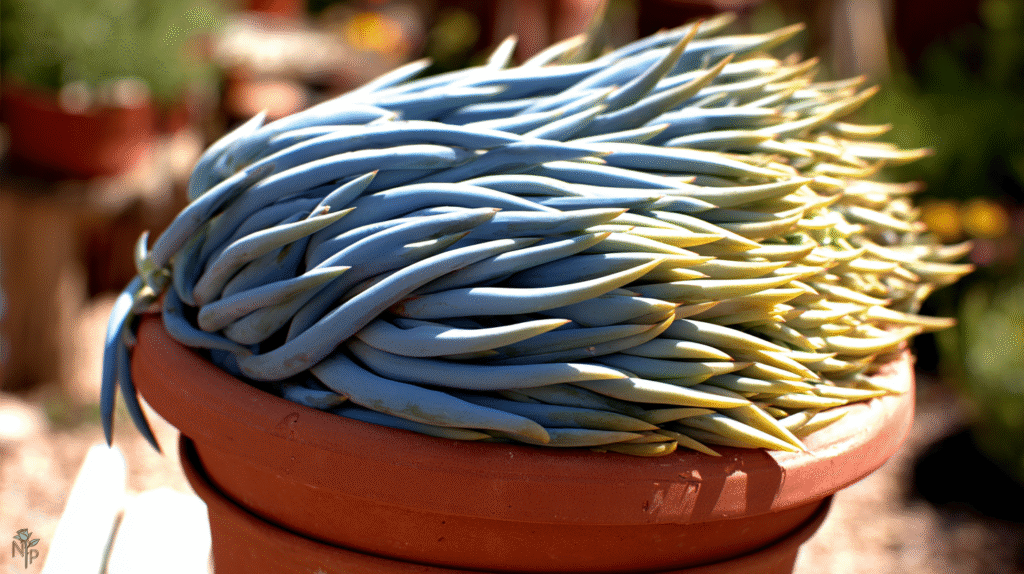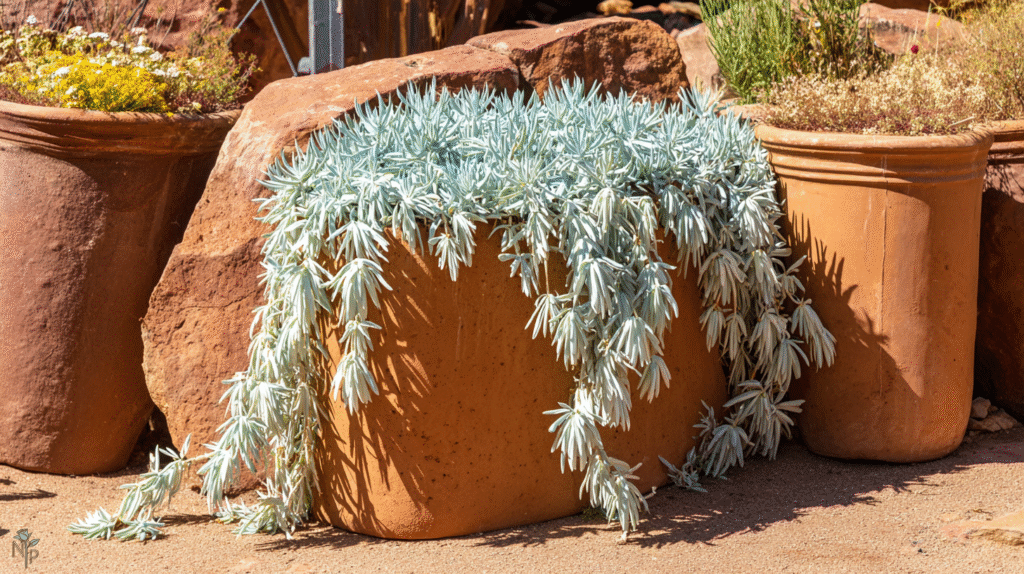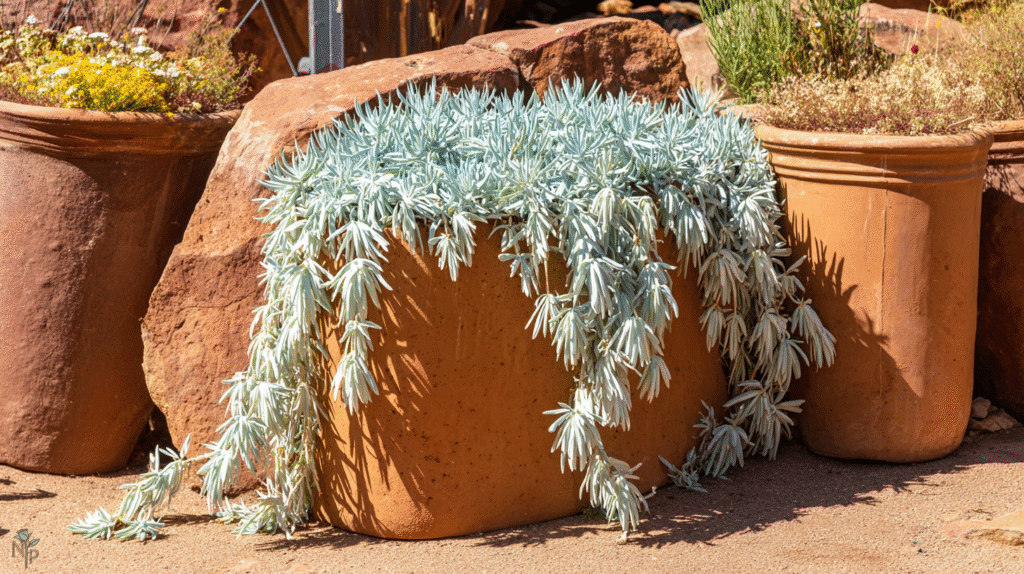I bought my first chalksticks succulent because it looked like someone had dusted blue chalk all over fat little fingers. “Senecio serpens” the tag said, but I just saw a weird alien plant that I absolutely needed. Four dollars at Home Depot. Into the cart it went.
Two months later, that blue chalk coating was gone, the “fingers” were stretched and green, and the whole thing looked more like a sad asparagus than the compact blue beauty I’d bought. Turns out, I’d been caring for it like my other houseplants — regular water, indoor light, general fussing. Chalksticks, I learned the hard way, want the exact opposite.
Three years and many chalksticks later (they multiply like rabbits once happy), I finally understand these powder-blue weirdos. They’re actually one of the easiest succulents IF you respect their very specific preferences. Here’s everything I wish I’d known from day one.
What Makes Chalksticks Different
That blue-white powder coating (called farina) isn’t just for looks — it’s their sunscreen and water conservation system rolled into one. Touch it and it rubs off, leaving permanent fingerprints on your plant. Ask me how I know.
This coating tells you everything about what chalksticks want:
- Blazing sun (hence the natural sunscreen)
- Minimal water (the coating prevents evaporation)
- Hands-off care (touching removes protection)
- Extreme drainage (they’re cliff dwellers in nature)
My first mistake was treating that coating like it was decorative. It’s functional. Once I understood this, everything about their care made sense.
Light: More Sun Than You Think Possible
“Full sun succulent” undersells it. Chalksticks want ALL the sun. Every ray. No mercy.
Indoor reality check: That sunny windowsill? Not enough. My first chalksticks in an east window stayed green and stretched. Moved to a south window pressed against the glass? Still reached for more light.
What actually works:
- Outside in direct sun (ideal)
- South window + grow light (acceptable)
- West window in desert climates
- Under powerful grow lights alone
My chalksticks only got their blue color back when I put them outside for summer. The transformation was dramatic — compact growth, intense powder blue color, even some pink edges when stressed. Now they summer outside and winter under grow lights.
The stretching disaster: Low light makes chalksticks etiolate (stretch) fast. Mine went from compact 3-inch fingers to 8-inch green noodles in one winter indoors. Once stretched, they never compact again. You have to cut and propagate to fix it.

Water: The Less-Is-More Philosophy
This is where people murder chalksticks — with kindness. They need less water than almost any succulent I’ve grown.
My watering evolution:
- Started weekly (plant looked sad)
- Moved to biweekly (still too much)
- Monthly (getting better)
- Now: when I remember, usually every 3-6 weeks
Signs they need water:
- Fingers start to wrinkle slightly
- Feel less firm when gently squeezed
- Powder coating looks less vibrant
Signs of overwatering:
- Fingers turn translucent
- Yellow or mushy spots
- Suddenly dropping fingers
- Black stem (game over)
The chalksticks I water least look best. The one I forgot about for two months last summer? It’s my fullest, bluest specimen. They thrive on neglect.
Soil: Hostile and Fast-Draining
Regular succulent soil from the store? Still too rich for chalksticks. They want soil that seems hostile to life.
My chalksticks mix:
- 40% coarse sand
- 30% perlite
- 20% cactus soil
- 10% small gravel or pumice
This drains so fast water barely touches the roots. Perfect. In nature, they grow in cliffsides and rock crevices where water never lingers.
Container choice: Terracotta only. The porosity helps soil dry even faster. That cute glazed pot? That’s a chalksticks coffin. Learned this after losing one to root rot in a beautiful ceramic pot with “drainage.” Terracotta isn’t pretty but it works.
Temperature: Tougher Than They Look
Those delicate-looking fingers handle temperature extremes better than most succulents:
Heat: Laughs at 100°F+ if dry Cold: Survives light frost (25°F) briefly
But here’s the catch — they can’t handle cold AND wet. Winter rain killed my outdoor chalksticks until I learned to cover them or move them under eaves. Dry cold? Fine. Wet cold? Death.
My zones 9b solution: They stay outside year-round under the roof overhang. Protected from rain but still get temperature fluctuations that keep them compact and colorful.
Propagation: Ridiculously Easy
This redeems all their pickiness. Chalksticks propagate from everything:
Fallen fingers: Stick in soil, ignore, new plant in weeks Cuttings: Let dry 2 days, plant, water after week Leaves: Even single leaves root sometimes
I went from one plant to fifteen through casual propagation. Every piece that falls off gets stuck in a pot. Success rate is probably 90%. They WANT to multiply.
The accident that started everything: Knocked over my first chalksticks, breaking multiple fingers. Instead of crying, I stuck them all in soil. Two months later: six new plants. Now I “accidentally” break pieces off regularly.

Seasonal Changes and Color
Chalksticks change dramatically with seasons:
Summer: Blue-green, growing actively Fall: Pink/purple edges appear with temperature drops Winter: Deepest blue color, minimal growth Spring: Growth explosion, flowers if mature
That pink edging in fall? Chef’s kiss. Happens when night temperatures drop but days stay warm. Stress coloring at its finest.
The flowering surprise: Year three, mine flowered — small white blooms on tall stalks. Not showy but the bees went crazy for them. Cut stalks after blooming to redirect energy to growth.
Common Problems Solved
Lost blue coating:
- Usually from touching or overhead watering
- New growth will have coating
- Can’t restore old growth
- Hands off!
Green instead of blue:
- Not enough light, always
- Move to brighter spot gradually
- Add grow lights if needed
- Be patient for new growth
Leggy/stretched growth:
- Light deficiency again
- Cut and propagate tops
- Give stumps more light
- They’ll branch at cut point
Sudden mushiness:
- Overwatering finally caught up
- Cut above mushy part immediately
- Let dry, propagate healthy portion
- Adjust watering down
Indoor vs. Outdoor Reality
Let’s be honest — chalksticks want to live outside. But if indoor is your only option:
Minimum requirements:
- Brightest window possible
- Supplemental grow lights
- Exceptional drainage
- Minimal water
- Accept less blue color
My indoor chalksticks survive but don’t thrive like outdoor ones. They’re greener, less compact, but still alive. Sometimes that’s victory enough.

Why I Keep Growing These Weirdos
They’re not the easiest succulents. They demand more sun than seems reasonable. Touch them wrong and they’re permanently marked. But successfully grown chalksticks are absolutely stunning.
That powder blue color catches everyone’s eye. The way they cascade from containers like frozen waterfalls. How they glow pink-edged in fall. Plus, they’re conversation starters — nobody expects succulents to be blue.
My original $4 Home Depot rescue has produced dozens of plants. I’ve given away cuttings to anyone who asks. Started a chalksticks exchange with neighbors. All from understanding what that chalk coating was trying to tell me.
Your Chalksticks Success Formula
- Maximum sun possible (really, more than you think)
- Water when you remember them (monthly-ish)
- Soil that drains instantly
- Terracotta pots only
- Don’t touch the powder coating
- Propagate fallen pieces always
- Accept indoor limitations
The learning curve is steep but short. Once you understand they want extreme sun and extreme drainage, they’re nearly indestructible. My chalksticks went from struggling survivors to the stars of my succulent collection.
Just remember: that blue powder coating is telling you everything. It’s saying “I evolved for intense desert conditions.” Respect that message, and you’ll have blue beauties cascading from every pot. Fight it, and you’ll have expensive green asparagus. The choice is yours. 💙






